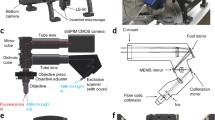Abstract
Virtual microscopy (i.e., the viewing of entire microscope specimens on a computer display) is becoming widely applied in microscopy teaching and clinical laboratory medicine. Despite rapidly increasing use, virtual microscopy currently lacks of a universally accepted image format. A promising candidate is JPEG2000, which has potential advantages for handling gigabyte-sized virtual slides. To date, no JPEG2000-based software has been specifically suited for virtual microscopy. To study the utility of JPEG2000 in virtual microscopy, we first optimized JPEG2000 code-stream parameters for virtual slide viewing (i.e., fast navigation, zooming, and use of an overview window). Compression using ratios 25:1–30:1 with the irreversible wavelet filter were found to provide the best compromise between file size and image quality. Optimal code-stream parameters also consisted of 10 wavelet decomposition levels, progression order Resolution-Position-Component-Layer (RPCL), a precinct size of 128 × 128, and code-block size of 64 × 64. Tiling and the use of multiple quality layers were deemed unnecessary. A compression application (JVScomp) was developed for creating optimally parameterized JPEG2000 virtual slides. A viewing application (JVSview) was developed specifically for virtual microscopy, offering all of the basic viewing functions. JVSview also supports viewing of focus stacks, embedding of textual descriptions, and defining regions of interest as metadata. Combined with our server application (JVSserv), virtual slides can be viewed over networks by employing the JPEG2000 Interactive Protocol (JPIP). The software can be tested using virtual slide examples located on our public JPIP server (http://jvsmicroscope.uta.fi/). The software package is freely downloadable and usable for noncommercial purposes.

Similar content being viewed by others
References
Weinstein RS: Innovations in medical imaging and virtual microscopy. Hum Pathol 36(4):317–319, 2005
Lundin M, Lundin J, Helin H, Isola J: A digital atlas of breast histopathology: an application of web based virtual microscopy. J Clin Pathol 57(12):1288–1291, 2004
Kumar RK, Freeman B, Velan GM, De Permentier PJ: Integrating histology and histopathology teaching in practical classes using virtual slides. Anat Rec B New Anat 289(4):128–133, 2006
Lundin M, Lundin J, Isola J: Virtual microscopy. J Clin Pathol 57(12):1250–1251, 2004
Helin H, Lundin M, Lundin J, Martikainen P, Tammela T, Helin H, van der Kwast T, Isola J: Web-based virtual microscopy in teaching and standardizing Gleason grading. Hum Pathol 36(4):381–386, 2005
Furness P: A randomized controlled trial of the diagnostic accuracy of internet-based telepathology compared with conventional microscopy. Histopathology 50(2):266–273, 2007
Rojo MG, García GB, Mateos CP, García JG, Vicente MC: Critical Comparison of 31 Commercially Available Digital Slide Systems in Pathology. Int J Surg Pathol 14(4):285–305, 2006
Burthem J, Brereton M, Ardern J, Hickman L, Seal L, Serrant A, Hutchinson CV, Wells E, McTaggart P, De la Salle B, Parker–Williams J, Hyde K: The use of digital ’virtual slides’ in the quality assessment of haematological morphology: results of a pilot exercise involving UK NEQAS(H) participants. Br J Haematol 130(2):293–296, 2005
Zoomify, Inc., USA: Zoomify image server software. Available at http://www.zoomify.com/. Accessed 12 July 2007
The Joint Photographic Experts Group website. Available at http://www.jpeg.org/. Accessed 12 July 2007
Information technology—JPEG 2000 image coding system: Core coding system. ISO/IEC 15444-1, 2000 | ITU-T Recommendation T.800, 2002
Taubman DS, Marcellin MW: JPEG2000: Image Compression Fundamentals, Standards and Practice: Springer, 2002
Skodras A, Christopoulos C, Ebrahimi T: The JPEG 2000 Still Image Compression Standard. IEEE Signal Proc Mag 18(5):36–58, 2001
Rabbani M, Joshi R: An overview of the JPEG 2000 still image compression standard. Signal Process: Image Comm 17(1):3–48, 2002
Information technology—JPEG 2000 image coding system: Extensions. ISO/IEC 15444-2, 2002 | ITU-T Recommendation T.801, 2002
Information technology—JPEG 2000 image coding system: Interactivity tools, APIs and protocols. ISO/IEC 15444-9, 2005 | ITU-T Recommendation T.808, 2005
Taubman DS, Prandolini R: Architecture, Philosophy and Performance of JPIP: Internet Protocol Standard for JPEG2000. Proc SPIE 5150:791–805, 2003
Tuominen VJ, Isola J, University of Tampere, Finland: LargeMontage—a Java application for creating large image montages. Available at http://iki.fi/vtuo/software/largemontage/. Accessed 12 July 2007
Rasband WS, U.S. National Institutes of Health, USA: ImageJ image analysis software. Available at http://rsb.info.nih.gov/ij/. Accessed 12 July 2007
Taubman DS, The University of New South Wales, Australia: Kakadu JPEG2000 Framework. Available at http://www.kakadusoftware.com/. Accessed 12 July 2007
The Apache Software Foundation, USA: The Apache HTTP Server Project. Available at http://httpd.apache.org/. Accessed 12 July 2007
Earth Resource Mapping Ltd., Australia: ER Mapper Image Compression SDK. Available at http://www.ermapper.com/. Accessed 12 July 2007
Gao M, Bridgman P, Kumar S: Computer Aided Prostate Cancer Diagnosis Using Image Enhancement and JPEG2000. Proc SPIE 5203:323–334, 2003
Tuominen VJ, Isola J, University of Tampere, Finland: JVSschema: a metadata XML schema for the JVS software. Available at http://jvsmicroscope.uta.fi/jvsschema/. Accessed 12 July 2007
Santa-Cruz D, Grosbois R, Ebrahimi T: JPEG 2000 performance evaluation and assessment. Signal Process: Image Comm 17(1):113–130, 2002
Ebrahimi F, Chamik M, Winkler S: JPEG vs. JPEG2000: An Objective Comparison of Image Encoding Quality. Proc SPIE 5558:300–308, 2004
Aware Systems, Belgium: The BigTIFF File Format Proposal. Available at http://www.awaresystems.be/imaging/tiff/bigtiff.html. Accessed 10 October 2007
Digital Imaging and Communications in Medicine (DICOM). Available at http://medical.nema.org/dicom/2007/. Accessed 12 July 2007
Digital Imaging and Communications in Medicine (DICOM), Supplement 61: JPEG 2000 Transfer Syntaxes. Available at ftp://medical.nema.org/medical/dicom/final/sup61_ft.pdf. Accessed 12 July 2007
Digital Imaging and Communications in Medicine (DICOM), Supplement 106: JPEG 2000 Interactive Protocol. Available at ftp://medical.nema.org/medical/dicom/final/sup106_ft.pdf. Accessed 12 July 2007
Digital Imaging and Communications in Medicine (DICOM), Strategic Document & Principal Contacts. Available at http://medical.nema.org/dicom/geninfo/Strategy.pdf. Accessed 10 October 2007
Acknowledgement
This study was financially supported by the Finnish Cancer Foundation, Sigrid Juselius Foundation, and an EVO-grant from Tampere University Hospital.
Author information
Authors and Affiliations
Corresponding author
Rights and permissions
About this article
Cite this article
Tuominen, V.J., Isola, J. The Application of JPEG2000 in Virtual Microscopy. J Digit Imaging 22, 250–258 (2009). https://doi.org/10.1007/s10278-007-9090-z
Received:
Revised:
Accepted:
Published:
Issue Date:
DOI: https://doi.org/10.1007/s10278-007-9090-z




